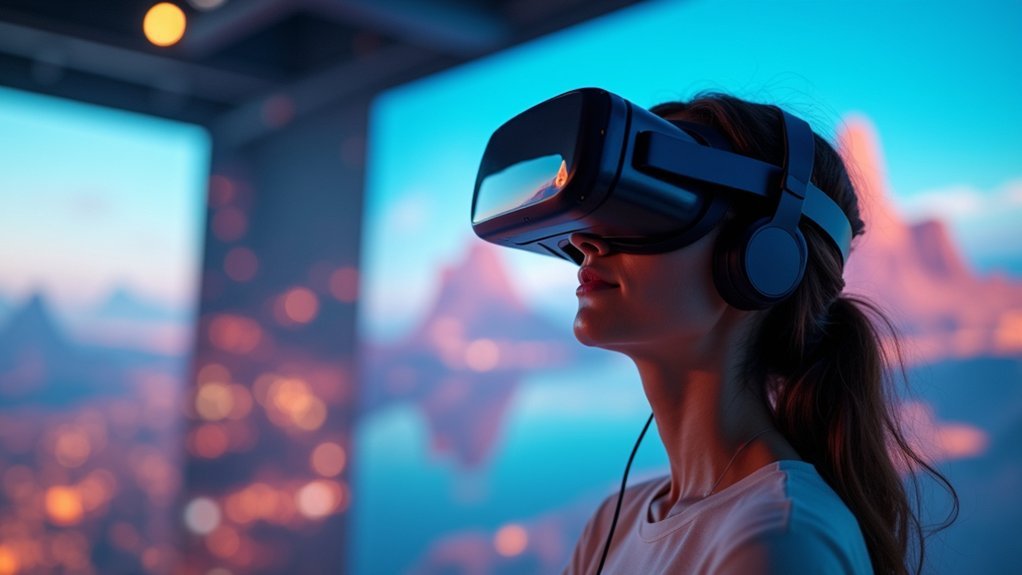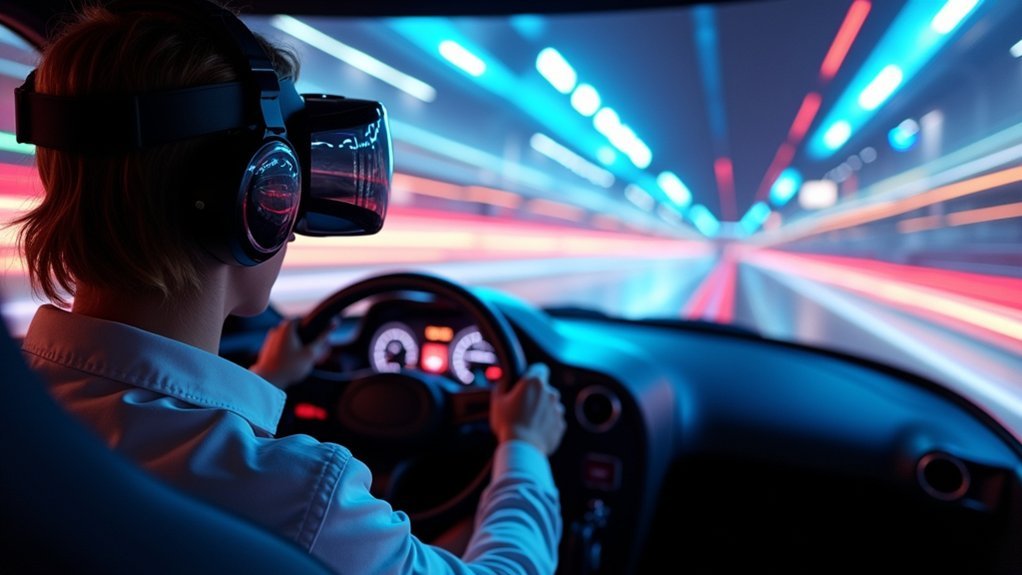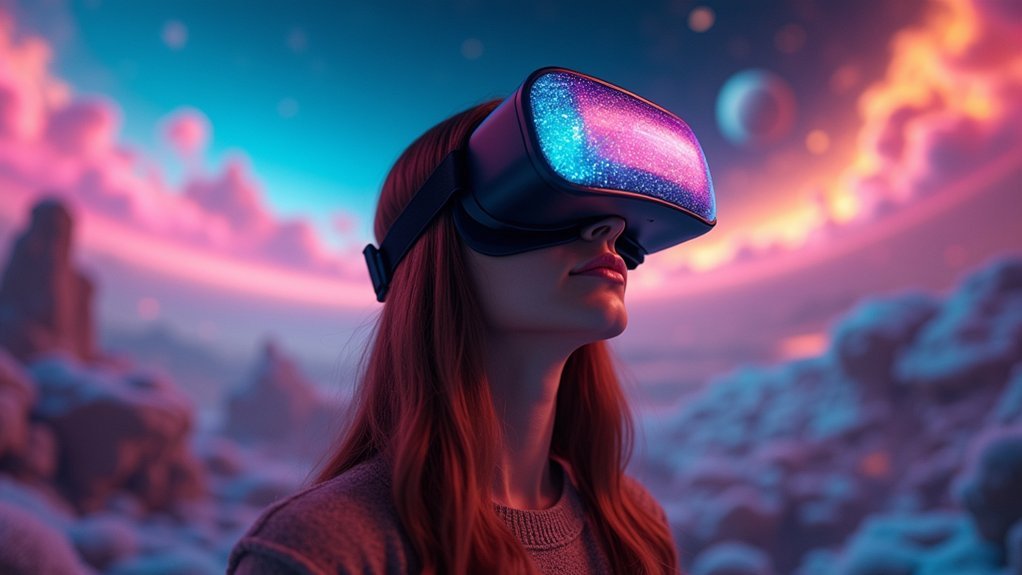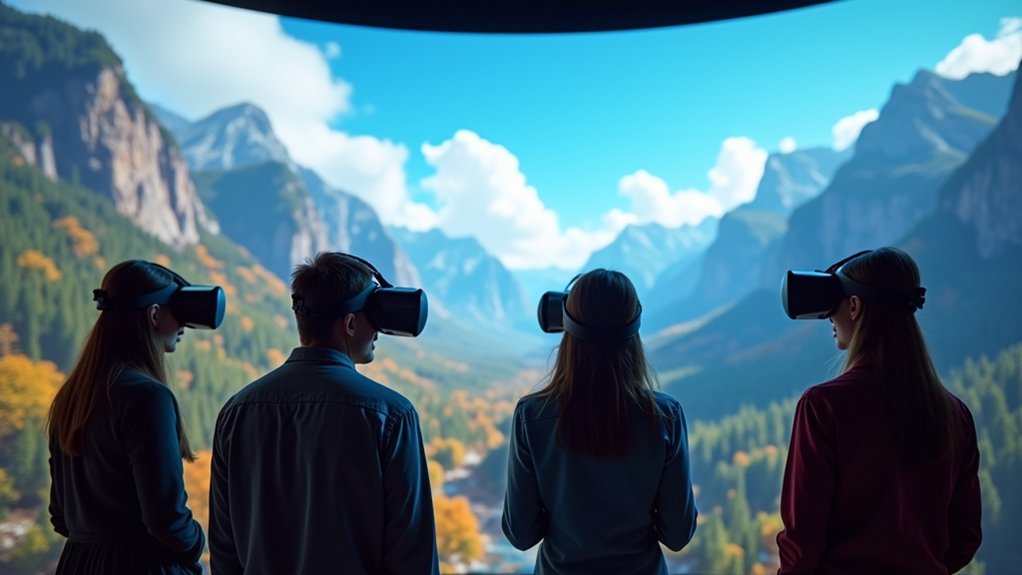Wide FOV in VR simulations dramatically improves your immersion by matching your natural 210-degree human vision instead of forcing you to peer through a narrow tunnel. You’ll experience reduced motion sickness, enhanced spatial awareness, and better peripheral vision that lets you spot competitors and track edges naturally in racing sims. Headsets like the Pimax 5K+ offer 170° FOV compared to standard 90-110° devices, creating more authentic visual environments that eliminate discomfort and enhance your decision-making abilities during extended sessions.
Understanding Field of View in Virtual Reality

Field of view represents the foundation of immersive VR experiences, determining how much of the virtual world you can see at any given moment. When you wear a VR headset, the FOV fundamentally creates your window into the digital environment, measured in degrees across your visual field.
You’ll encounter three distinct FOV measurements: horizontal, vertical, and diagonal. The diagonal field of view serves as the primary metric that directly impacts your VR experience quality. A wider FOV closely replicates your natural human vision, markedly boosting spatial awareness and presence within virtual environments.
Your comfort and engagement levels depend heavily on the visible area your headset provides. Hardware limitations, optical design, and software enhancement all influence the effective FOV you’ll experience, making headset selection essential for peak immersion.
The Science Behind Wide FOV and Human Vision
When you look at the world around you, your eyes capture an impressive 210-degree horizontal field of view that VR developers endeavor to replicate. Your visual system naturally divides this experience into distinct zones that work together seamlessly.
Understanding how wide FOV aligns with human vision reveals why it’s vital for immersive VR:
Wide FOV isn’t just a technical specification—it’s fundamental for creating VR experiences that feel genuinely natural to your visual system.
- Your central foveal vision provides sharp detail while peripheral areas detect motion and shapes.
- Wide FOV reduces motion sickness by matching your natural vision patterns.
- Spatial awareness improves when VR systems utilize your full visual capabilities.
- Speed and depth perception become more authentic with expanded viewing angles.
- Enhanced peripheral awareness creates stronger immersion in virtual environments.
This scientific foundation explains why wider FOV isn’t just a technical specification—it’s fundamental for creating VR experiences that feel genuinely natural to your visual system.
How FOV Enhances Immersion in VR Racing

Racing simulators demonstrate these visual principles in action, where every degree of peripheral vision can mean the difference between victory and collision. When you’re using a headset with a 170° Field of View like the Pimax 5K+, you’ll experience dramatically enhanced immersion compared to narrower alternatives. You can spot track edges, monitor mirrors, and detect approaching opponents naturally without head movement.
| FOV Range | Immersion Level | Racing Experience |
|---|---|---|
| 170° (Pimax 5K+) | Maximum | Natural peripheral awareness |
| 110° (Samsung Odyssey) | Limited | Tunnel vision effect |
| <100° | Minimal | Restricted situational awareness |
This wider Field of View replicates authentic racing conditions where drivers experience limited head movement due to G-forces, making your virtual racing feel genuinely realistic and engaging.
Peripheral Vision and Situational Awareness Benefits
When you’re racing in VR with a wide field of view, you’ll notice how much easier it becomes to spot competitors approaching from your sides without constantly turning your head.
Your eyes can naturally scan the track edges and monitor multiple elements simultaneously, just like they’d in real-world driving situations.
This enhanced peripheral vision dramatically improves your ability to anticipate challenges and react quickly to changing track conditions.
Enhanced Track Awareness
As you navigate through challenging corners and overtaking maneuvers, a wider field of view becomes essential for maintaining awareness of your surroundings without constantly turning your head.
Enhanced track awareness through wider FOV transforms your racing experience by reducing that confined feeling and increasing comfort during extended sessions.
Your improved track awareness manifests through several key advantages:
- Natural eye movement monitoring – You’ll rely on peripheral vision instead of constant head turning
- Speed and positioning judgment – Better gauge your velocity relative to track boundaries and competitors
- Reduced head rotation – Studies show up to 50% less need for head movement
- Immersive realism – Mimics real-world driving’s 200° to 220° horizontal vision
- Superior decision-making – Enhanced visibility leads to faster, more accurate racing choices
Natural Eye Movement
While traditional VR headsets force you to rely heavily on head movements to scan your environment, wider FOV technology releases your natural peripheral vision capabilities.
With wide FOV headsets like the Pimax 5K+ offering 170° vision, you’ll experience eye movement patterns that mirror real life. You can glance at side mirrors, check approaching competitors, and monitor track conditions using subtle eye shifts rather than constant head turning.
This natural scanning reduces physical fatigue considerably. Your neck muscles won’t strain from excessive movement, allowing longer, more comfortable racing sessions.
The realistic eye movement mechanics also improve your reaction times since you’re processing visual information through instinctive peripheral awareness rather than deliberate head positioning, creating a more authentic and responsive driving experience.
FOV Impact on Motion Sickness and Comfort

When you’re using VR with a wide field of view, you’ll notice a dramatic reduction in motion sickness because the expanded visual field better matches your natural peripheral vision.
You’ll experience enhanced comfort levels that allow for longer gaming or training sessions without the nausea and disorientation that plague narrower FOV setups.
This improvement stems from your brain receiving visual information that’s more consistent with what it expects, eliminating the sensory disconnect that triggers motion sickness.
Reducing Motion Sickness Effects
Since your brain struggles to reconcile conflicting signals between what you see and what your body feels, motion sickness becomes a common barrier to enjoying VR experiences.
Wider FOV (Field of View) greatly reduces these uncomfortable symptoms by creating more natural visual conditions.
When you experience VR with expanded FOV settings, several benefits work together to minimize motion sickness:
- Enhanced peripheral vision helps your brain better process spatial relationships and movement
- Reduced tunnel vision effect eliminates the confined feeling that triggers discomfort
- Natural visual field mimicking (120+ degrees) aligns with human vision expectations
- Improved spatial awareness allows better reconciliation between visual and physical sensations
- Increased immersion distracts from potential nausea symptoms during extended sessions
These improvements create more comfortable, enjoyable VR experiences with fewer interruptions.
Enhanced Comfort Levels
Although motion sickness remains VR’s most persistent challenge, wider FOV settings directly address comfort concerns by eliminating the restrictive visual boundaries that cause physical discomfort. You’ll experience enhanced comfort levels when your VR headset provides a field of view that matches your natural vision patterns, creating an authentic visual environment that reduces strain and disorientation.
| Narrow FOV Effects | Wide FOV Benefits |
|---|---|
| Tunnel vision feeling | Natural peripheral awareness |
| Physical eye strain | Reduced visual fatigue |
| Claustrophobic sensation | Open, unrestricted experience |
When you’re immersed in simulations with wider FOV, your spatial awareness improves dramatically. You’ll maintain better balance and orientation because your peripheral vision receives adequate visual information, making virtual experiences feel less artificial and more engaging throughout extended sessions.
Comparing Different FOV Modes in VR Headsets
While most VR headsets lock you into a single field of view, the Pimax 5K+ breaks this limitation by offering three distinct FOV modes—170°, 150°, and 125°—that greatly alter your racing experience.
The difference becomes stark when you compare these options to fixed-FOV competitors like the Samsung Odyssey’s restrictive 110°:
Fixed FOV headsets create tunnel vision that severely limits your peripheral awareness and competitive edge in racing simulations.
- 170° Large mode – You’ll see mirrors and A-pillars clearly, gaining complete situational awareness.
- 150° Medium mode – Balanced peripheral vision without performance compromises.
- 125° Small mode – Still wider than most headsets but feels restrictive like a scuba mask.
- Samsung Odyssey’s 110° – Limits mirror visibility and track edge awareness considerably.
- Wide FOV advantages – Enhanced speed sensation and realistic driver perspective.
Pimax headsets deliver this flexibility while competitors force you into tunnel vision that diminishes immersion and competitive advantage.
Technical Limitations and Hardware Considerations
Despite the impressive FOV capabilities demonstrated by headsets like the Pimax 5K+, your VR experience ultimately depends on hardware constraints that manufacturers must navigate carefully.
You’ll find that optics quality and display technology directly limit how wide manufacturers can push the field of view. Advanced lens designs in higher-end headsets enable broader FOV ranges, but they’re expensive to produce and require precise engineering.
When you’re using Pimax headsets with their multiple FOV modes, you’re experiencing how manufacturers balance performance with technical feasibility.
Your individual anatomy also affects FOV effectiveness – ideal lens distance varies between users, impacting your perceived field of view.
Additionally, you’ll notice that external lighting conditions and manufacturing design limitations can influence clarity and overall FOV performance during simulation use.
Optimizing FOV Settings for Maximum Performance
Understanding these hardware constraints helps you make informed decisions when configuring your VR setup for peak performance.
You’ll achieve maximum engagement by leveraging your headset’s full FOV (Field of View) potential and fine-tuning in-game settings to match your comfort preferences.
To optimize your VR technology experience:
- Maximize hardware FOV: Use headsets like Pimax 5K+ (170°) over Samsung Odyssey (110°) for superior peripheral vision
- Adjust in-game FOV settings: Customize field of view to enhance opponent tracking without excessive head movement
- Tailor comfort settings: Balance performance with personal comfort to reduce discomfort and boost immersion
- Optimize racing simulations: Implement wider FOVs for realistic speed sensation and spatial awareness
- Update regularly: Keep hardware and software current for improved FOV performance and rendering techniques
Frequently Asked Questions
What’s a Good FOV for VR?
You’ll want between 110-170 degrees FOV for VR. Wider FOVs like 150-170 degrees provide better immersion and spatial awareness, mimicking natural vision. Narrower settings feel restrictive, while wider ones enhance comfort and engagement considerably.
What Is PPD in VR?
PPD measures how many pixels you’ll see within one degree of your field of view in VR headsets. Higher PPD means you’ll experience sharper visuals and reduced screen-door effects for better immersion.
What Is the Highest FOV in Pimax?
You’ll get the highest FOV of 170 degrees with Pimax headsets in Large mode. This setting maximizes your peripheral vision, though you can choose Normal (150°) or Small (125°) modes for better performance.
What Is the Difference Between Resolution and FOV?
Resolution determines how sharp and detailed your VR visuals appear, while FOV controls how much of the virtual world you can see around you, affecting your sense of immersion.





Leave a Reply